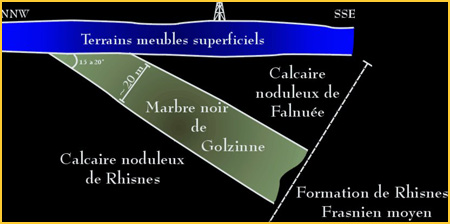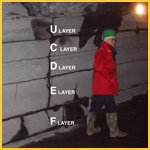
Position of the “Noir belge“
marble underground
quarry.

Most belgium marble deposits belongs to
Palaezoique period around Devonian and Carboniferous eras
and their black color is due to a high contain of unaltered
organic matter.
The Noir belge marble deposit belongs to a fine-grained
calcareous sedimentary formation dated Frasnian era (Upper
Devonian – around 360 millions years ago) and located
on the northern border of Namur sedimentary basin.
Figure 2 : Geological cross-section of the Meuse river
and position of the black marble formation.
The marble is bedded in thin layers from 15 to 55 cm
thick gently dipping toward south around 20°. While
block thickness is limited so are not lenght and height.
Large sizes are available on requirement.

Originally worked
on open ground, the quarry is operated since beginning
of XXth century in mines with the rooms ans
pillars methods. Exploration is today occuring at a medium depth of 75 meters underground. Very specific equipment are required
for the exploration. As the recovery is very small, annual
production doesn’t excess 500
cubic meters.
The five main marble layers being exploited are named
U, C, D, E and F. Their thickness is given as follow
:

U Layer : +/- 40 cm
C Layer : +/- 34 cm
D Layer : +/- 40 cm
E Layer : +/- 55 cm
F Layer : +/- 36 cm

